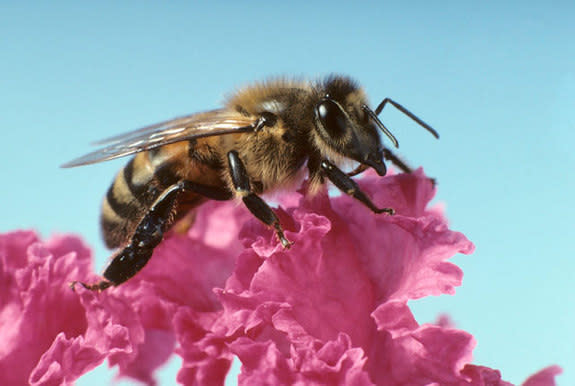Bee Brains Inspire Tiny Drone Intelligence
Droning sounds of honeybees flitting from blossom to blossom could eventually transform into the lazy drone of robotic bees doing the same thing. The "Green Brain" project aims to pave the way for the first flying robots capable of sensing and behaving like real bees.
The robotic bees could search tight spaces for survivors of earthquakes and other disasters, scout enemy-held buildings ahead of human soldiers, or even ensure mechanical pollination of crops and wildflowers. Such robots would channel the brainpower of a honeybee's brain, which has 100,000 times fewer brain cells compared with a human — small enough for researchers to conceivably build an artificial bee intelligence, but also capable of making sophisticated decisions.
"This small size means that it is actually feasible to start thinking about a simulation of the entire brain without splashing out on a warehouse-sized supercomputer," said James Marshall, a computer scientist at the University of Sheffield in the U.K.
Marshall and his U.K. colleagues received $1.6 million (1 million euro) from the Engineering and Physical Sciences Research Council to start creating simulations of a bee's brain over the next three years. They plan to join their efforts with U.S. colleagues working on a separate "Robobees" project to build the tiny flying robots that would house the artificial bee intelligence.
Honeybees have just 1 million brain cells, called neurons, compared with 100 million for rats or 100 billion for humans. But honeybee experts and neuroscientists have found that tiny bee brains still have the capabilities of many larger brains, Marshall said. He said his favorite example of bee brainpower is their ability to learn the "choose the same" rule. [Quiz: Sci-Fi vs. Real Technology]
"Bees can learn that a particular odor they detect at the entrance to a maze predicts which odor to follow within the maze in order to find food," Marshall told TechNewsDaily. "Then, without any further learning, the bees can apply the same rule, but this time following visual patterns that they've never encountered before in that context."
The first generation of the artificial bee brain could first be tested in an off-the-shelf robot that already has an onboard camera and Wi-Fi transmitter, rather than the tiny robotic bees of the future. Researchers plan to add a smell sensor and rewrite the robot's software so that it looks to a separate computer running the brain simulation for commands.
"In fact, we plan to work with the kind of flying quad-copter toys that you can buy for a few hundred dollars and control with your iPad or your phone," Marshall said.
Whatever its appearance, a flying robot that can navigate new environments and "learn" on its own would represent a huge leap forward for artificial intelligence and robots. The Green Brain team hopes to simulate the bee's brain areas that deal with smell, vision and behavior during their three-year project, even if simulating an entire bee brain could still take decades.
Luckily, researchers don't have to wait on a free supercomputer to get started. The NVIDIA Corporation donated graphics processing unit (GPU) accelerators to create a powerful network of standard desktop computers. Such GPUs have typically generated the 3D graphics for home PCs and video game consoles, but growing numbers of scientists have begun harnessing their computing power for research. Some of the world's most high-performance supercomputers also use GPUs.
A single GPU accelerator could replace the equivalent of 20 traditional computers, said Thomas Nowotny, a senior research fellow at the University of Sussex in the U.K. and a collaborator on the Green Brain project. He added that the GPU accelerators could help their bee brain software run 10 to 100 times faster than on a single traditional computer core.
"As a rough guess, using traditional computers, we think one would need some 100 [computer] cores to simulate the type of model we have in mind in real time," Nowotny said.
This story was provided by TechNewsDaily, a sister site to LiveScience. You can follow TechNewsDaily Senior Writer Jeremy Hsu on Twitter @jeremyhsu. Follow TechNewsDaily on Twitter @TechNewsDaily, or on Facebook.
Copyright 2012 LiveScience, a TechMediaNetwork company. All rights reserved. This material may not be published, broadcast, rewritten or redistributed.




